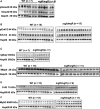An integrative systems approach identifies novel candidates in Marfan syndrome-related pathophysiology
- PMID: 30677223
- PMCID: PMC6433740
- DOI: 10.1111/jcmm.14137
An integrative systems approach identifies novel candidates in Marfan syndrome-related pathophysiology
Abstract
Marfan syndrome (MFS) is an autosomal dominant genetic disorder caused by mutations in the FBN1 gene. Although many peripheral tissues are affected, aortic complications, such as dilation, dissection and rupture, are the leading causes of MFS-related mortality. Aberrant TGF-beta signalling plays a major role in the pathophysiology of MFS. However, the contributing mechanisms are still poorly understood. Here, we aimed at identifying novel aorta-specific pathways involved in the pathophysiology of MFS. For this purpose, we employed the Fbn1 under-expressing mgR/mgR mouse model of MFS. We performed RNA-sequencing of aortic tissues of 9-week-old mgR/mgR mice compared with wild-type (WT) mice. With a false discovery rate <5%, our analysis revealed 248 genes to be differentially regulated including 20 genes previously unrelated with MFS-related pathology. Among these, we identified Igfbp2, Ccl8, Spp1, Mylk2, Mfap4, Dsp and H19. We confirmed the expression of regulated genes by quantitative real-time PCR. Pathway classification revealed transcript signatures involved in chemokine signalling, cardiac muscle contraction, dilated and hypertrophic cardiomyopathy. Furthermore, our immunoblot analysis of aortic tissues revealed altered regulation of pSmad2 signalling, Perk1/2, Igfbp2, Mfap4, Ccl8 and Mylk2 protein levels in mgR/mgR vs WT mice. Together, our integrative systems approach identified several novel factors associated with MFS-aortic-specific pathophysiology that might offer potential novel therapeutic targets for MFS.
Keywords: Chemokine signalling; Igfbp2 signalling; Marfan syndrome; Mfap4; RNA-sequencing; Spp1; TGF-beta signalling; Transcriptomics; mgR/mgR.
© 2019 The Authors. Journal of Cellular and Molecular Medicine published by John Wiley & Sons Ltd and Foundation for Cellular and Molecular Medicine.
Conflict of interest statement
The authors declare no potential conflict of interest.
Figures




Similar articles
-
Dimorphic effects of transforming growth factor-β signaling during aortic aneurysm progression in mice suggest a combinatorial therapy for Marfan syndrome.Arterioscler Thromb Vasc Biol. 2015 Apr;35(4):911-7. doi: 10.1161/ATVBAHA.114.305150. Epub 2015 Jan 22. Arterioscler Thromb Vasc Biol. 2015. PMID: 25614286 Free PMC article.
-
Impact of Notch3 Activation on Aortic Aneurysm Development in Marfan Syndrome.J Immunol Res. 2022 Feb 15;2022:7538649. doi: 10.1155/2022/7538649. eCollection 2022. J Immunol Res. 2022. PMID: 35211631 Free PMC article.
-
Glycoproteomic Analysis of the Aortic Extracellular Matrix in Marfan Patients.Arterioscler Thromb Vasc Biol. 2019 Sep;39(9):1859-1873. doi: 10.1161/ATVBAHA.118.312175. Epub 2019 Jul 18. Arterioscler Thromb Vasc Biol. 2019. PMID: 31315432 Free PMC article.
-
Pathophysiology and Management of Cardiovascular Manifestations in Marfan and Loeys-Dietz Syndromes.Int Heart J. 2016 May 25;57(3):271-7. doi: 10.1536/ihj.16-094. Epub 2016 May 13. Int Heart J. 2016. PMID: 27181042 Review.
-
Recent progress in genetics of Marfan syndrome and Marfan-associated disorders.J Hum Genet. 2007;52(1):1-12. doi: 10.1007/s10038-006-0078-1. Epub 2006 Oct 24. J Hum Genet. 2007. PMID: 17061023 Review.
Cited by
-
Assessment of Bones Deficient in Fibrillin-1 Microfibrils Reveals Pronounced Sex Differences.Int J Mol Sci. 2019 Dec 1;20(23):6059. doi: 10.3390/ijms20236059. Int J Mol Sci. 2019. PMID: 31805661 Free PMC article.
-
Deletion of AT1a (Angiotensin II Type 1a) Receptor or Inhibition of Angiotensinogen Synthesis Attenuates Thoracic Aortopathies in Fibrillin1C1041G/+ Mice.Arterioscler Thromb Vasc Biol. 2021 Oct;41(10):2538-2550. doi: 10.1161/ATVBAHA.121.315715. Epub 2021 Aug 19. Arterioscler Thromb Vasc Biol. 2021. PMID: 34407634 Free PMC article.
-
Effects of fibrillin mutations on the behavior of heart muscle cells in Marfan syndrome.Sci Rep. 2020 Oct 7;10(1):16756. doi: 10.1038/s41598-020-73802-w. Sci Rep. 2020. PMID: 33028885 Free PMC article.
-
Coding and Non-Coding Transcriptomic Landscape of Aortic Complications in Marfan Syndrome.Int J Mol Sci. 2024 Jul 5;25(13):7367. doi: 10.3390/ijms25137367. Int J Mol Sci. 2024. PMID: 39000474 Free PMC article. Review.
-
Genetically engineered animal models for Marfan syndrome: challenges associated with the generation of pig models for diseases caused by haploinsufficiency.J Reprod Dev. 2022 Aug 1;68(4):233-237. doi: 10.1262/jrd.2022-027. Epub 2022 May 23. J Reprod Dev. 2022. PMID: 35598970 Free PMC article.
References
-
- Pereira L, Andrikopoulos K, Tian J, et al. Targetting of the gene encoding fibrillin‐1 recapitulates the vascular aspect of Marfan syndrome. Nat Genet. 1997;17:218‐222. - PubMed
Publication types
MeSH terms
Substances
LinkOut - more resources
Full Text Sources
Medical
Molecular Biology Databases
Research Materials
Miscellaneous

